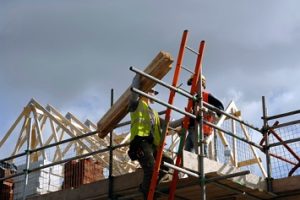We know falls in the workplace are preventable and yet falls remain the leading cause of death in construction. According to the Bureau of Labor Statistics (BLS), more than 300,000 workers in the United States sustained nonfatal injuries from slips, trips, and falls in 2015. Fatalities caused by falls from heights in construction accounted for 350 of the 937 fatalities recorded in 2015.

DaveBolton / E+ / Getty Images
But preventing falls is more than a matter of life and death; it can also mean the difference between saving money and costly safety fines, as fall prevention standards were among the top 10 most frequently cited Occupational Safety and Health Administration (OSHA) standards during 2016.
OSHA recommends this 3-step process for preventing construction-related falls:
- Plan ahead to get the job done safely. When working from heights, you must plan projects to ensure that the job is done safely. Begin by deciding how the job will be done, what tasks will be involved, and what safety equipment may be needed to complete each task.
- Provide the right equipment. Workers who are 6 feet or more above lower levels are at risk for serious injury or death if they should fall. To protect them, employers must provide fall protection and the right equipment for the job, including the right kinds of ladders, scaffolds, and safety gear.
- Train everyone to use the equipment safely. Every worker should be trained on proper setup and safe use of equipment they use. Workers must be trained in recognizing hazards on the job.
Workers also have a responsibility in fall prevention. Workers must:
- Understand your company’s written fall prevention plan.
- Attend and participate in fall prevention training.
- Use fall-protection equipment, if required for the job. Be sure the equipment is right for the task, fits properly, and is in good condition.
- Inspect fall protection equipment and devices before each use.
- Make sure that floor holes, open shafts, and riser penetrations are protected by sturdy guardrails or covers.
- Get specialized training before working on scaffolds, lifts, or ladders.
- When using scaffolds, make sure there is proper access, full planking, stable footing, and guardrailing.
- Keep your feet firmly on the platform on a boom lift, and tie-off at all times.
- Chose the correct ladder for the task, read the instructions, and be sure that the ladder is in good condition. Check for surrounding hazards, stable footing, and the proper angle.
- Identify skylights, and make sure they are properly protected.
- Contact your supervisor if you see fall hazards or have any questions about fall prevention. Do not work until unsafe conditions have been corrected.
To make sure that more construction workers make it home safely every night, it’s crucial that we take a stand to prevent falls by reinforcing the importance of fall prevention.
